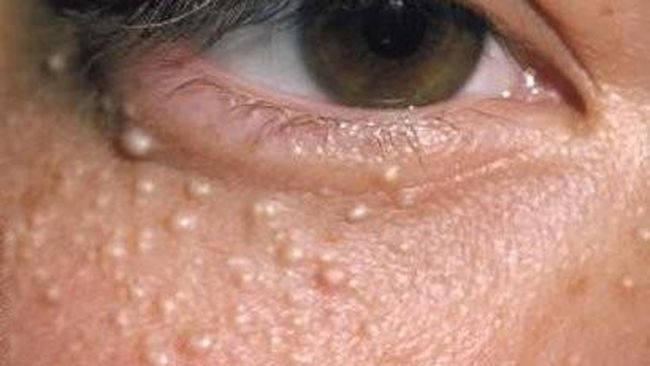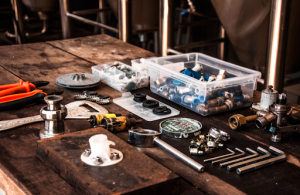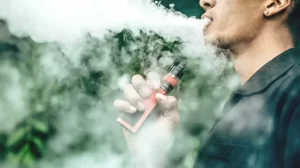Milia Unveiled: A Comprehensive Guide to Clear, Healthy Skin

In the grand tapestry of life, our skin often serves as a reflection of our overall health and well-being. One common skin concern that affects people of all ages is milia. Milia are tiny, white cysts that often appear on the face, resembling small pearls. While they are generally harmless, understanding the factors that contribute to their development, prevention strategies, and available treatments can be valuable for maintaining healthy, radiant skin.
Understanding Milia Formation
Milia, often referred to as “milk spots,” are small, dome-shaped cysts that form when dead skin cells become trapped beneath the surface of the skin. Unlike acne, milia are not caused by bacteria or oils, but rather by the skin’s inability to naturally exfoliate these cells. This trapping occurs when keratin, a protein found in the outer layer of the skin, becomes trapped in small pockets near the surface, leading to the formation of tiny, white bumps.
Factors Contributing to Milia Development
Several factors contribute to the development of milia, and understanding these triggers is crucial for effective prevention. One key factor is poor exfoliation, which can be a result of using heavy, oil-based skincare products that hinder the natural shedding of dead skin cells. Additionally, milia are more common in adults, particularly those with dry or dehydrated skin.
Vitamin B12, an essential nutrient for cell development, has also been linked to the formation of milia. While B12 is crucial for overall health, excessive intake, often through supplements, can lead to imbalances that contribute to skin issues. Maintaining a well-balanced diet and consulting with a healthcare professional can help regulate vitamin B12 levels.
Prevention Approaches: A Holistic Perspective
Preventing It involves adopting a holistic approach that considers various aspects of life, skincare, and nutrition. One fundamental aspect is a proper skincare routine that promotes regular exfoliation. Using gentle exfoliants containing alpha hydroxy acids (AHAs) or beta hydroxy acids (BHAs) can help remove dead skin cells and prevent their accumulation.
Hydration plays a vital role in skin health, and maintaining adequate moisture levels is essential for preventing milia. Choosing lightweight, non-comedogenic moisturizers can hydrate the skin without clogging pores, reducing the risk of Its formation.
Incorporating a balanced diet rich in vitamins and minerals is another preventive measure. Ensuring an adequate intake of vitamin A, C, and E can contribute to overall skin health. Avoiding excessive vitamin B12 supplements and consulting with a healthcare professional for personalized advice is advisable.
Ayurveda, the ancient Indian system of medicine, offers holistic approaches to skincare. Traditional practices such as oil cleansing and herbal remedies may aid in maintaining skin balance. Consulting with an Ayurvedic practitioner can provide personalized recommendations based on individual constitution and needs.
Home Remedies for Milia
For those already dealing with It, several home remedies may help reduce their appearance. Gently exfoliating the skin with a mixture of sugar and honey can aid in removing dead skin cells. Aloe vera gel, known for its soothing properties, may also assist in promoting skin health.
However, it’s crucial to approach home remedies with caution, as overly aggressive methods can potentially worsen the condition or cause irritation. If milia persist or become bothersome, seeking professional advice is recommended.
Professional Treatments for Milia
In some cases, professional interventions may be necessary for effective milia removal. Dermatologists offer various treatments, including microdermabrasion, chemical peels, and laser therapy, which can help exfoliate the skin and encourage the removal of milia. Extraction performed by a skincare professional is a common method, involving the careful removal of the cyst using specialized tools.
Diagnosis and When to Seek Professional Help
While It are generally harmless, it’s essential to differentiate them from other skin conditions. Consulting with a dermatologist for a proper diagnosis is advisable if there is uncertainty about the nature of skin bumps. Dermatologists can evaluate the condition, rule out potential underlying issues, and recommend an appropriate course of action.
Conclusion
Navigating the world of skincare involves understanding the intricacies of our skin and adopting preventive measures to maintain its health. It though benign, can be a source of concern for many individuals. By embracing a holistic approach that considers factors such as skincare routines, nutrition, and lifestyle, we can foster an environment that promotes healthy, radiant skin. Whether through preventive measures or professional treatments, addressing It allows us to put our best face forward in the world.








